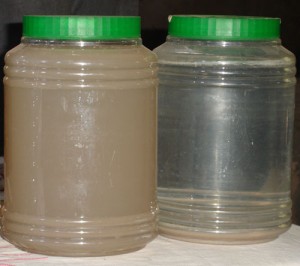 Planting Moringa
Planting Moringa
The best time to plant moringa seeds is at the beginning of the rainy season. Ideal conditions include sandy loam soil, temperatures of 22c to 34c (72f to 93f), and rainfall of 700mm to 900mm (27 in. to 35 in.), but moringa is very tolerant of imperfect conditions (including drought) and once established is relatively easy to maintain.
For good seed production trees should be planted with 3 meter spacing (10 ft). If the goal is to maximize leaf production, trees should be planted close together. Moringa may also be used to create a living fence or planted randomly around the property as space allows.
- Three to four weeks before planting dig holes 60cm (24″) round and 60cm (24″) deep, separate top half and bottom half of removed dirt into two piles.
- Mix top soil pile with 1-2 shovelfuls of manure and put back in hole, then put remaining pile of dirt back into hole. It is best if dirt is somewhat mounded so that water cannot pool around trunk of tree. Moringa will die if it remains flooded for too long.
- It is best to plant seeds just prior to the start of the rainy season. Plant 2-3 seeds per hole 2cm to 3cm (.75 to 1.25″) deep.
- Germination will require 6 to 15 days.
- When saplings reach .5 meter (20″), remove weakest carefully so that roots of remaining tree are not damaged. Extra saplings can be transplanted to any empty holes. Keep area around saplings free of weeds.Pruning Your Trees
Moringa grows very quickly and so must be pruned aggressively in the first year to encourage lateral growth and increased production, as well as ease of harvesting.
- When tree reaches a height of 1 meter (3.25′) cut to height of .5 meter (20″).
- When tree reaches a height of 1.5 meters (5′) cut to height of 1 meter (3.25′).
- When tree reaches a height of 2 meters (6.5′) cut to height of 1.5 meter (5′).
- When tree reaches a height of 2.5 (8′) meters cut to height of 2 meters (6.5′).
- Flowers will appear around 4-9 months.
- Seed pods will mature at around 12 months.
- When harvesting leaves or seed pods prune trees to height of 2 meters (6.5′).
Intensive Planting – this planting option will produce large quantities of leaves on a small plot of land.
 This is an excellent planting method when the goal is to produce lots of leaves to either consume fresh or for drying to make powder. It is perfect for families who don’t have much land or for those who wish to sell fresh leaves and powder in their local market. This method does not produce full-sized trees or seeds.
This is an excellent planting method when the goal is to produce lots of leaves to either consume fresh or for drying to make powder. It is perfect for families who don’t have much land or for those who wish to sell fresh leaves and powder in their local market. This method does not produce full-sized trees or seeds.
Planting:
- Dig trenches about 30cm (12″) deep, leaving walking space between the trenches.
- Add manure if available.
- Add water.
- Return the dirt to the trenches making mounded rows.
- Plant seeds in a straight line on top of each mounded row. Plant them 2-3cm deep (.75-1.25″), 10-15cm apart (4-6″ – about the width a hand with fingers spread apart).
- Water well.
Harvesting:
- When moringa plants reach approximately 1.5 meters tall (5′), cut to 15cm (6″). Use leaves fresh or dry for powder.
- Depending on amount of leaves needed, rows can be harvested at different times. Harvesting rows at different times will assure that there will always be leaves ready to harvest as they are needed.
- Plants will continue to grow back with more branches and leaves after each harvest.
- This method will provide a continuous supply of leaves.
Eating Moringa
Moringa can be eaten fresh, cooked or as a dried powder.
To eat fresh pick the youngest leaves and wash. If eaten raw be sure to wash in clean water.
If cooking, it is best to cook for as short of a time as possible, so add the moringa last to whatever you cook with it.
To eat dried powder you may add the powder to any food or beverage. In cooked food or beverages it is best to add the moringa powder last, just before serving.
Preparing Moringa Powder
- Harvest leaves by pruning branches from trees.
- Wash leaves to remove dirt and dust.
- Drying must be done in the shade, preferably indoors in a clean, well ventilated space. If leaves are dried in the sun, the vitamin content will be reduced.
- Hang upside down or lay on a drying rack of string mesh to insure good air flow. Turn or move as needed to prevent rotting or molding during drying process.
- After leaves are completely dry remove from stems and crush into a powder.
- Store powder in an airtight container in a dark place.
Drinking Water Treatment
- Use seeds from mature dried seed pods.
- Remove the outer shell of the seed to reach the white seed kernel.
- Crush the seed kernel into a powder. It takes two tablespoons of seed powder to clean 20 liters (5 gal) of water (approximately 20 seeds).
- Put two tablespoons of seed powder into .5 liter (2 cups) of clean water in bottle and shake for 5 minutes.
- Pour powder and water solution into 20 liter container of dirty water.
- Stir rapidly for 5 minutes, and then stir at a moderate rate for an additional 10-15 minutes.
- Cover container and allow water to stand without being disturbed for 2-3 hours or longer until impurities have settled to the bottom.
- Being careful to not disturb sediments in bottom of container, slowly pour treated water through a cloth filter into a clean container.
This water is now 90-99% pure. Since there are some impurities remaining in the water, it should be used within 24-48 hours. For those who are not able to boil their water, this treatment provides a great improvement in water quality and will reduce water-borne illnesses which, in the developing world, is the largest cause of death in children under 5 years of age.

Both containers in this photo were drawn from the same well at the same time in Kashaguru, Tanzania. The water in the container on the right was treated with moringa seed powder using the method above. After approximately 2 hours, the water was clear.




